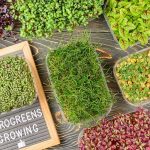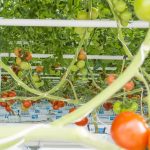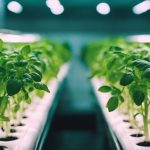Want to know how to grow hydroponic tomatoes at home? It is an exciting venture for gardening enthusiasts and those looking for fresh, homegrown produce regardless of the season. Hydroponic gardening offers a soil-free alternative to traditional cultivation, making it feasible to grow tomatoes inside your home or outdoors in places with limited space. By opting for a hydroponic system, you provide your tomato plants with a controlled environment, which can lead to faster growth and potentially higher yields compared to soil-based gardening.
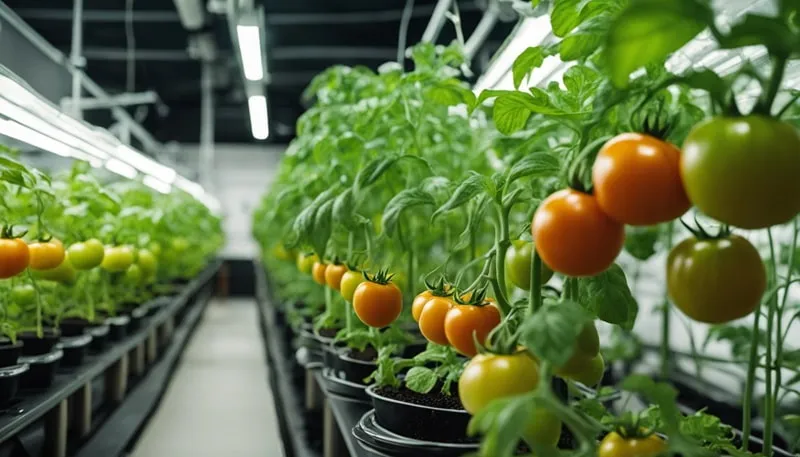
In hydroponic gardening, your tomatoes will receive their nutrients directly from a water-based solution, ensuring they have constant access to the essential elements they need for growth. By carefully managing this nutrient solution, you can prevent common soil-borne diseases and eliminate weeds, making hydroponics a lower maintenance option compared to traditional gardening. This method also allows you to grow tomatoes year-round, free from the constraints of weather and outdoor conditions, providing a continuous supply of fresh and tasty produce right from the comfort of your home.
How Fast Do Hydroponic Tomatoes Grow?
Growing tomatoes hydroponically allows for a quicker development compared to traditional soil gardening. When you provide your tomato plants with optimal hydroponic conditions, they can mature up to 30% to 50% faster than they would in soil. This accelerated growth means you can enjoy ripe tomatoes in less time. Typically, you can begin harvesting tomatoes within 60 to 80 days after planting seeds for most varieties. However, exact times can vary based on the tomato type and conditions of your hydroponic setup.
The hydroponic system you choose also plays a part in the growth rate. Some popular systems include:
- Aeroponics: Fine mist feeds the roots, maximizing oxygen exposure.
- Nutrient Film Technique (NFT): Constant flow of nutrient solution runs past the roots.
- Hydroponic Drip: Slow, steady nutrient delivery directly to each plant.
Each system has its own advantages for tomato growth. The key to speedier growth is a combination of proper nutrition, adequate lighting (whether artificial or natural), and the right temperature and humidity levels.
A well-maintained hydroponic system not only helps tomatoes grow faster but can also lead to a higher yield. With the ideal environment free from soil-borne diseases and pests, it’s possible to produce more tomatoes per plant compared to traditional methods.
Related: Is hydroponic growing faster than soil?
Getting Started with Hydroponic Tomatoes
Embarking on the journey of growing hydroponic tomatoes at home can be both rewarding and efficient. It is one of the easiest fruits to grow hydroponically. You’ll find success comes easier when you carefully select the best hydroponic tomato varieties. Start with quality seeds, pick a suitable hydroponic system, and set up an optimal indoor growing area.
Choosing Tomato Varieties for Hydroponic Growing
When selecting tomato varieties for your hydroponic garden, consider smaller or determinate types as they often adapt better to indoor conditions. Look for varieties such as ‘Cherry’, ‘Grape’, or ‘Roma’, which are known for their compact growth and bountiful yields in hydroponic setups. We also have a comprehensive guide on choosing the best hydroponic tomato varieties for disease resistance, growth habit, yield, and many more factors.
How to Start Tomato Seeds for Hydroponics
Begin with high-quality, disease-resistant tomato seeds. Plant them in a sterile starter mix or rockwool cubes, keeping them moist until they sprout. If using a seed starting tray, fill each cell with your chosen medium, plant the seeds, and lightly cover them with a growing medium.
Ensure the seedlings receive ample light – about 14-16 hours daily. Either use grow lights placed a few inches above or rotate the tray regularly in front of a sunny window. Maintain a temperature range of 65-80 degrees Fahrenheit to promote strong growth. Gently water the seeds so that the medium should be moist but not waterlogged.
Once the seedlings have developed their first true leaves (the second set of leaves after the initial seed leaves or cotyledons), you can begin to introduce a mild hydroponic nutrient solution. If you planted multiple seeds per cube or cell and more than one seedling emerges, thin them out by snipping the weaker seedlings at the base with scissors. This allows the strongest seedling to continue growing without competition.
When the seedlings have developed several sets of true leaves and are sturdy enough to handle, they can be transplanted into your hydroponic system. Transplanting usually occurs a few weeks after germination. Carefully move each seedling into its new hydroponic container, ensuring the roots are well supported and have direct contact with the nutrient solution or moistened growing medium.
Choosing the Best Hydroponic System for Tomatoes
Numerous hydroponic systems are suitable for tomatoes, such as:
- Deep Water Culture (DWC): The roots are suspended in nutrient-rich water, ideal for beginners.
- Nutrient Film Technique (NFT): A continuous flow of nutrients over roots, great for space efficiency.
- Ebb and Flow: Periodically floods the roots with solution, then drains back, suited for larger plants.
Consider the size of your growing space and the time you can dedicate to maintenance when choosing.
Related: What is the best container to grow tomatoes hydroponically? Find out based on various factors.
Setting Up Your Indoor Growing Area
Your growing area should have:
- Sufficient light: LED or HID lamps work best for tomato plant growth.
- Controlled temperature: Aim for 65-80 degrees Fahrenheit.
- Proper air circulation: Keep air moving with fans to strengthen plants and prevent disease.
- Suitable humidity: Maintain a range of 40-60% to ensure optimal growth conditions.
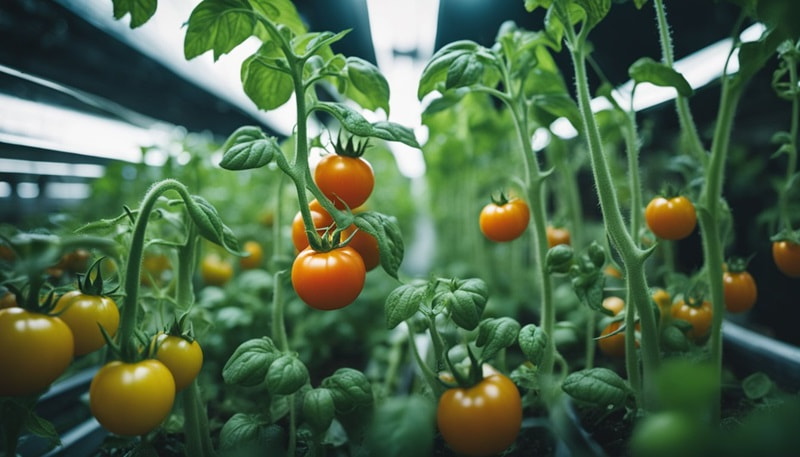
Essential Components of Hydroponic Growth
In hydroponic growing, your success with cultivating tomatoes heavily depends on the precision of your setup. Here’s what you need to ensure optimal growth for your hydroponic tomatoes.
Light Requirements
Light is critical for plant growth and fruit production. For hydroponic tomatoes, LED grow lights are popular due to their efficiency and full spectrum of light. Your tomato plants should receive at least 14 to 18 hours of artificial light daily during the vegetative stage and 12 to 16 hours during the fruiting stage. This mimics the sunlight they crave and ensures photosynthesis can occur, translating to vibrant, healthy fruits.
Water and Nutrient Solution
Your tomatoes need a reliable water supply rich in nutrients. Here’s a simple guide for your setup:
- Reservoir: Use a clean, dark reservoir to store your water and nutrients.
- Nutrient Solution: Select the best hydroponic nutrients for tomatoes, which contain the right balance of nitrogen, potassium, and phosphorus.
- pH Levels: Regularly check the pH of your solution; it should be between 5.5 and 6.5 for tomatoes.
- Change Schedule: Replace the solution every 2-3 weeks to prevent nutrient deficiencies.
Temperature and Humidity Control
Temperature and humidity must be controlled to create an ideal environment for your hydroponic tomatoes. Maintain temperatures between 65°F and 75°F and humidity levels around 40-60%. This balance promotes healthy root development, prevention of disease, and efficient nutrient uptake.
The Role of Growing Medium
Choose the best growing medium for hydroponic tomatoes to anchor the roots and support your plants:
- Perlite, Vermiculite, and Coconut Coir: These mediums provide excellent aeration and moisture retention.
- Rockwool: Known for its water-holding capacity, it’s suitable for seed germination and supports the root system.
Remember to monitor for proper moisture levels, ensuring the roots can access both air and water without being waterlogged. Using a hydroponic tomato fertilizer in combination with these mediums can enhance plant nutrition and bolster growth.
Maintaining Your Hydroponic System
A successful hydroponic tomato garden hinges on the consistent maintenance of your system. The longevity and productivity of your tomato plants will greatly benefit from regular monitoring and adjusting of pH and nutrient levels, managing water quality, and correct pruning and supporting techniques.
Monitoring pH and Nutrient Levels
Your hydroponic tomatoes thrive in a pH range of 5.5 to 6.5. Use a pH meter to test the water regularly and adjust as necessary, aiming for the best pH for hydroponic tomatoes. For nutrients, an EC meter will measure the strength of the nutrient mix in the water. Ensure that nutrient concentrations follow the guidelines provided with your hydroponic system to meet the specific needs of your tomato plant.
Managing Water Quality and Usage
Water is the lifeblood of your hydroponic garden. Keep the water clean to prevent disease and ensure efficient use. Replace or top-up the nutrient mix according to the manufacturer’s instructions to provide a constant supply of essential minerals. Keep an eye on water usage; hydroponics is water-efficient, but checking for leaks and evaporative loss can save you from unexpected problems.
Pruning and Supporting Your Plants
As your tomato plants grow, pruning is essential to remove dead or yellowing leaves and to encourage fruitful growth. Use clean shears to make precise cuts that will heal quickly. Support your tomato plant using a trellis or similar structure to help it stay upright and allow for easy access to sunlight and air circulation, which is crucial for healthy growth and fruit production.
Optimizing Plant Growth
In growing hydroponic tomatoes at home, it’s important to focus on two critical aspects for successful cultivation: maximizing the yield and keeping plants healthy by preventing pests and diseases.
Enhancing Tomato Yield
To enhance your tomato yield, consider the following strategies:
- Proper Nutrient Solutions: Tailor your nutrient mixture to the specific needs of tomatoes, ensuring a balance of essential macro and micronutrients.
- Optimal Lighting: Use grow lights to provide your tomatoes with the ideal amount of light, mimicking the necessary daylight hours for robust growth.
- Pruning: Regularly prune your plants to encourage fruiting. This involves removing suckers and managing the canopy for better light penetration.
- Pollination: In hydroponics, you may need to assist in pollination by using a small brush or tuning a fan to help distribute pollen.
Preventing and Controlling Pests and Diseases
For a pest and disease-free environment:
- Prevention: Implement hygiene practices such as cleaning tools and systems regularly, and monitor plants closely for early signs of trouble.
- Natural Pesticides: When necessary, use organic pesticides that are safe for hydroponic systems. These can manage common pests without harming your plants.
- Controlled Environment: Take advantage of the controlled indoor environment to minimize the risk of diseases. Adjust temperatures and humidity levels to deter pathogen growth.
By being vigilant and adhering to these practices, you can enjoy a plentiful harvest of hydroponic tomatoes at home.
Harvesting and Storage
When your hydroponic tomatoes are ripe and ready, knowing how to properly harvest and store them will ensure you get to enjoy the fruits of your labor at their best quality.
Harvesting Tomatoes
You’ll want to harvest your tomatoes when they’ve reached full size and exhibit a uniform color—typically a vibrant red, although this can vary with different tomato varieties. Gently twist the fruit off the vine or use a pair of clean, sharp scissors to cut them, leaving a small part of the stem attached. Harvesting in the morning can often result in firmer fruit, which can be beneficial if you’re not planning on using them right away.
Storing Your Hydroponic Tomatoes
After harvesting, if you’re not going to consume your tomatoes immediately, store them at room temperature, away from direct sunlight. Refrigeration is not recommended, as it can diminish the flavor and make the texture mealy. Tomatoes are best enjoyed within a few days of picking, but proper storage can extend their shelf life up to a week. If you have more tomatoes than you can use, consider processing them into sauce, drying, or freezing for later use.
Expanding Beyond Tomatoes
As you master growing hydroponic tomatoes, you can elevate your home garden by introducing other vegetables and even creating a dedicated space for your hydroponic endeavors. Embrace the versatility of hydroponic systems to diversify your produce and extend your growing season.
Incorporating Other Vegetables
Once you’re comfortable managing the nutrient film technique or your chosen setup for beefsteak tomatoes or cherry tomatoes, consider adding new vegetable varieties to your hydroponic system. Peppers, for example, thrive in similar conditions to tomatoes and can expand your garden’s variety. They’re not only compatible in the hydroponic environment but also have comparable requirements for pH and nutrients.
A list of vegetables suitable for hydroponic systems includes, but is not limited to:
- Lettuce: A staple in hydroponic gardens due to its quick harvest cycle.
- Cucumbers: Ideal for trellis setups in hydroponic systems.
- Strawberries: Though fruit, they adapt well to hydroponic methods.
- Spinach: Another leafy green that responds well to hydroponic cultivation.
Building a Hydroponic Greenhouse
Elevate your hydroponic gardening by constructing a greenhouse, which offers a controlled environment, protecting your plants from external weather conditions. When designing a greenhouse for hydroponic systems, consider the specific needs of indeterminate and determinate tomato plants, as they require different support and spacing.
By incorporating diverse vegetables and potentially building your own hydroponic greenhouse, you create an extended, year-round growing season for a variety of fresh, home-grown vegetables.
Frequently Asked Questions
In this section, you’ll find answers to common inquiries about growing hydroponic tomatoes, provided to assist you in your hydroponic gardening endeavors.

